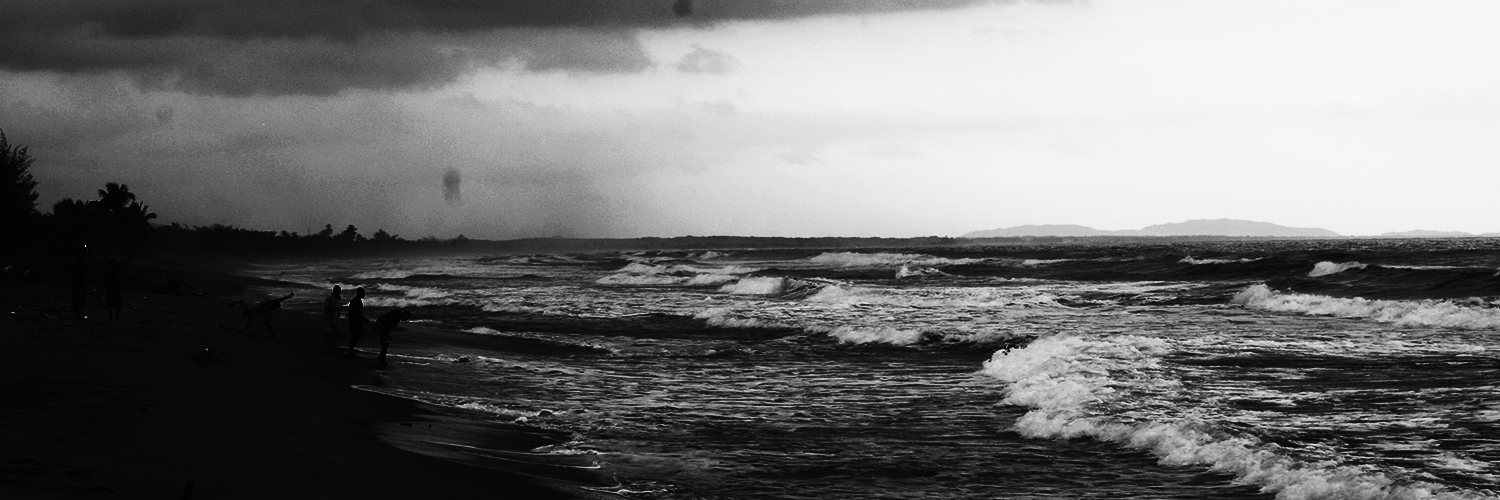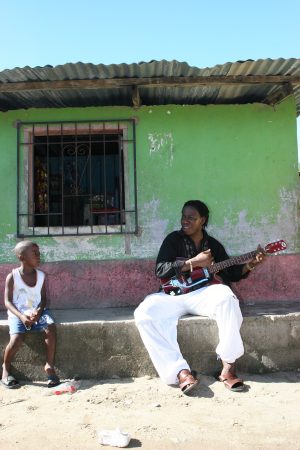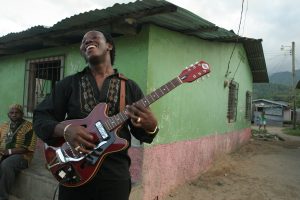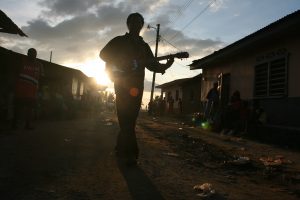
 Aurelio is the tradition bearer for a unique culture with African, Caribbean Indian, and Latin influences, but also a thoroughly modern artist determined to break new ground for his centuries-old roots.
Aurelio is the tradition bearer for a unique culture with African, Caribbean Indian, and Latin influences, but also a thoroughly modern artist determined to break new ground for his centuries-old roots.
Born in the tiny coastal hamlet of Plaplaya on Honduras’ Caribbean coast, Aurelio Martinez, 39, may be one of the last generations to grow up steeped in Garifuna tradition. These traditions encompass the African and Caribbean Indian roots of his ancestors, a group of shipwrecked slaves who intermarried with local natives on the island of St. Vincent, only to be deported to the Central American coast in the late eighteenth century.
Martinez recalls his humble but highly musical beginnings in his remote hometown. “In the village I was born, there is still no electricity,” Martinez told Afropop Worldwide in a 2006 interview.
He learned these chords from his family, including his father, a well-loved local troubadour who improvised playful paranda songs that embrace Garifuna roots and Latin sounds. He became a drummer almost as soon as he began to walk, thanks to his uncles and grandfather. From his vocally talented mother, he learned to sing and picked up many songs she crafted.
A prodigy of percussion, Martinez began performing at Garifuna ceremonies when just a boy, even at the most sacred events where children were usually not allowed. By the time he left Plaplaya to attend school at 14, he was a respected musician with a firm grounding in Garifuna rhythms, rituals, and songs.
While attending secondary school at the provincial capital of La Cieba, Martinez dove into diverse and innovative musical projects that took him outside the traditional sphere of performance. He played professionally with popular Latin ensembles, wrote music for theater and pop groups, and refined his musical skills with private teachers.
 He soon founded a Garifuna ensemble, Lita Ariran, one of the first Garifuna groups to appear on an internationally distributed recording. Martinez’s virtuosic musicianship and passionate performances made him a mainstay of the La Cieba music scene, where he was best loved for his take on punta rock, the high-energy, Garifuna roots-infused pop genre that took Central America by storm in the 1990s.
He soon founded a Garifuna ensemble, Lita Ariran, one of the first Garifuna groups to appear on an internationally distributed recording. Martinez’s virtuosic musicianship and passionate performances made him a mainstay of the La Cieba music scene, where he was best loved for his take on punta rock, the high-energy, Garifuna roots-infused pop genre that took Central America by storm in the 1990s.
His musical career took a global turn thanks to his Belizean friend and fellow musician Andy Palacio, who organized a major Garifuna festival and invited Martinez. The two artists struck up a decades-long friendship thanks in part to their shared hopes for the future of Garifuna music and culture.
Through Palacio Martinez met Ivan Duran, the tireless producer behind Belize’s Stonetree Records, and participated in a compilation of paranda, the Latin-inspired genre his father had favored, a style that was slowly dying out among the Garifuna. The comparatively youthful Martinez, youngest of the three generations on the recording, proved that the music was still alive and kicking.
With Duran, Martinez began thinking about the evolution of the music he had grown up with, and his first solo album Garifuna Soul (2004) explored his roots in both paranda and traditional rhythms. Martinez’s richly resonant voice and soulful acoustic songs caught the attention of the global music press and put Martinez on the map as a tradition-bearer with an innate musicality and subtle innovative streak.
 Devoting himself to a different approach to supporting and promoting Garifuna culture, Martinez set aside his music making for years as a legislator and politician.
Devoting himself to a different approach to supporting and promoting Garifuna culture, Martinez set aside his music making for years as a legislator and politician.
However, it was Palacio, himself involved in politics in Belize, and Duran who brought Martinez back to his first calling, music. In 2008, Palacio passed away unexpectedly at the young age of 48, leaving the Garifuna community stunned and bereft. ”Aurelio was still a congressman, but he left the congress session to go to Belize for the funeral,” Duran recalls. “He hadn’t been playing guitar for months because of his intense political commitments. But after Andy’s passing, he gave a few concerts and he knew he needed to start recording right away.”
Together with Duran, several veteran Garifuna musicians, and the occasional local ensemble dropping into the studio, Martinez began laying down the tracks for this recording in a cabana on the beach.
Taking up Palacio’s mantle as bard and advocate for his people, however, did not mean Martinez stopped his exploration of new approaches to Garifuna sounds, in particular their musical links with West Africa. Thanks to a mentorship with Afropop legend Youssou N’Dour (as part of the Rolex Mentor and Protégé Arts Initiative), Martinez found himself in Senegal, learning from the stunning singer, rethinking his arrangements, and meeting everyone from big names in Dakar (Orchestra Baobob, who recorded with Martinez) to unknown talents hanging out in the back alleys of the city’s poor medina.
“This album is about far more than just keeping tradition alive; it’s about urging people to action when they listen. We’re dealing with an emergency, and we don’t know if Garifuna music will survive,” muses Duran. “But this album will show people in Central America and around the world that Garifuna music is alive and well, and that artists are moving it forward.”
“We’re not going to let this culture die,” Martinez affirms. “I know I must continue the culture of my grandparents, of my ancestors, and find new ways to express it. Few people know about it, but I adore it, and it’s something I must share with the world.”